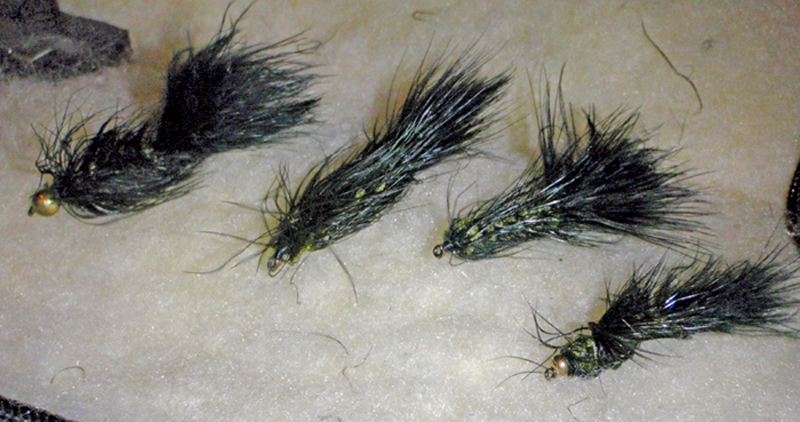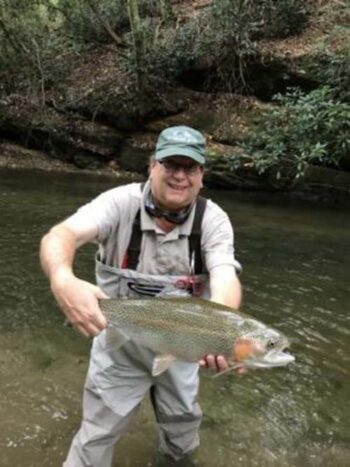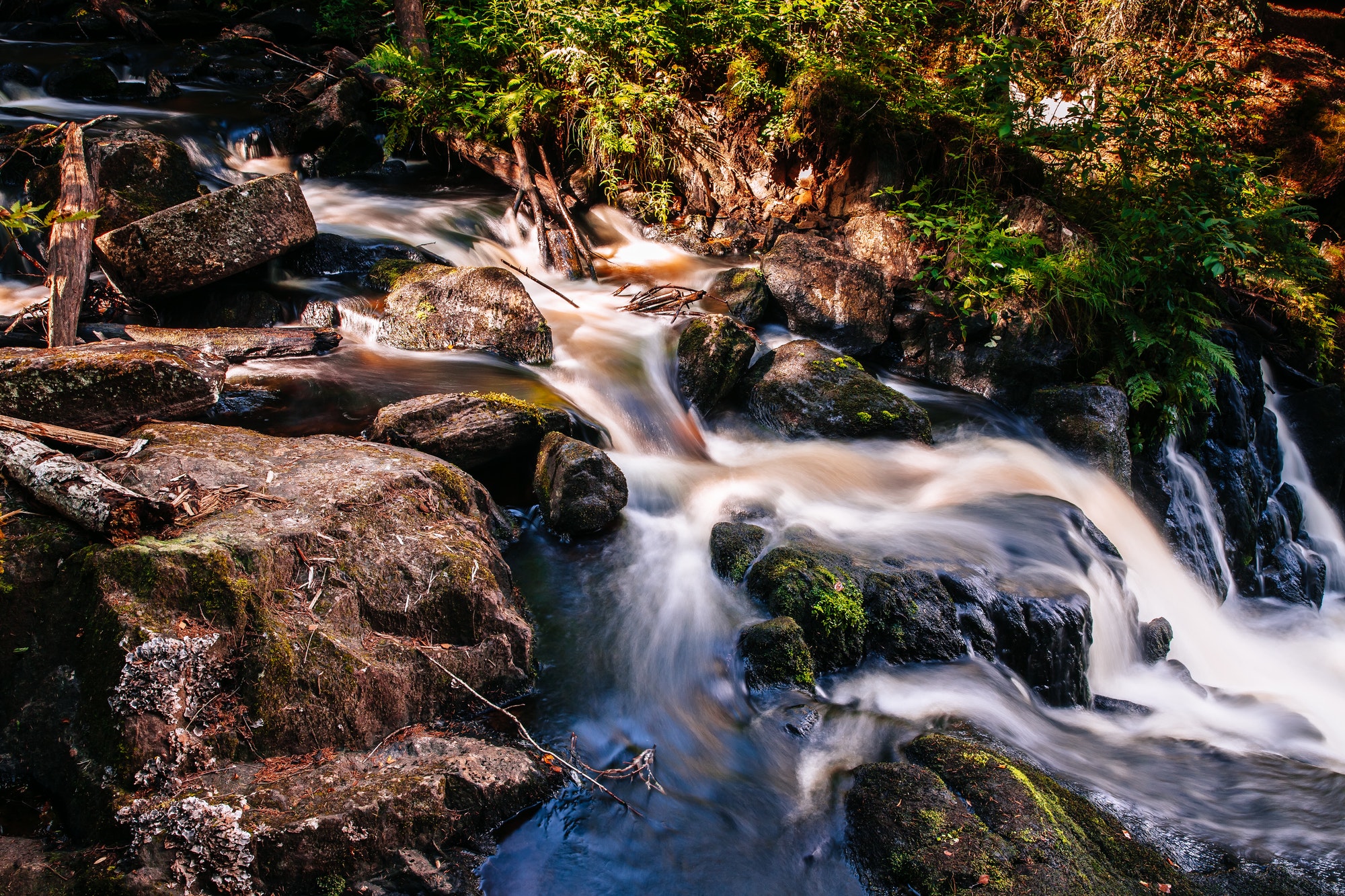Bream Buster novitiates tying their copies of Steve Hudson’s fly. He looks on with care—Hudson photo.
Unlike most other coordinates in the US with rainbows, brookies, and brown trouts, in the Southeast, Georgia, for example, can be found on 55° sunny days Christmas week and into the new year, or found overly hungry on back to back to back 67° days starting Groundhog Day.
Delayed Harvest [DH], as it is so-called by fisheries management departments, is a strategy that provides, principally, a high-quality catch and release trout opportunity from fall through spring.
Delayed Harvest, mainly Southeastern U. S. program, hosts excellent fishing for both sides of the trout angling world—anglers that want to keep fish and the angler that wants to practice catch and release.

The authors Delayed Harvest bug-out fly box readying itself for DH. Hudson photo.
DH: A stocking method that provides high catch rates for an excellent learning opportunity for new fly anglers
Additional restrictions keep the deadly treble hook, bait chucking folks off the water – requiring single hook and only artificials. In most Delayed Harvest practicing states, there are put-aside areas for fly fishing only.
Getting all your DH Harvest info from Steve Hudson is a good idea
One of the most knowledgeable fly fishers in the State of Georgia is also the author of several Georgia “outdoor” books – including Delayed Harvest. Hudson has agreed to give all of us a heads up on Georgia’s DH program, aside from start and end dates, mirrors programs of contiguous Southeastern states – and a few others. – Skip Clement
Top Flies for Delayed Harvest
By Steve Hudson / Chattahoochee Media / October 21, 2020

Steve Hudson, former field editor for Fly Life Magazine.com, at a local North Georgia fly shop – promoting fly tying. A Trent Sizemore image.
Used to be that fall brought an end to trout fishing in many areas. But thanks to a fisheries management concept known as “Delayed Harvest,” anglers in many states enjoy great catch-and-release trout fishing on certain designated waters through late fall, winter, and into spring.
The concept is straightforward. Assume that there’s a stream which is marginal for trout – that is, where water temperatures are too high for trout during the warmer months of the year.
But as summer gives way to fall, water temps start to drop. Eventually they reach a point where they’re cool enough for trout. Once they do, fisheries departments stock those waters with trout and then manage them on a catch-and-release, artificials-only basis through fall, winter, and early spring.
“It’s like a second trout season,” one of my buddies once said, and it can make for some remarkable wintertime trouting.
Here where I live in northern Georgia, the Delayed Harvest season starts on Nov. 1 and goes through May 14. Just up the road in North Carolina, it starts a bit earlier. I look forward to the arrival of “DH” every year, and it is with great anticipation that I start working on my DH fly box every fall.
What goes into that fly box? I’m glad you asked! The fact is that while most trout flies will work at least some of the time on DH water, it’s an established fact that certain patterns are better than others.
Every angler has his or her favorite DH flies, of course, but most seasoned DH anglers agree that there are certain key patterns which every Delayed Harvest enthusiast should have.
Let me show you what’s in my own DH box. Maybe that will give you some ideas on how to build your own Delayed Harvest fly set too.
Egg imitations
One thing to always remember about DH trout is that they are stocked fish. For most of their lives, the only food they saw was food pellets tossed their way as they swam in circles in a hatchery raceway. But then, suddenly, they find themselves in a real stream with not a single food pellet in sight. What’s a hungry trout to do?
Fall back on instinct, of course, and one thing that instinct says is “if it’s eggy, eat it!” Eggy, in this case, means roundish and pinkish or orangeish. Thus, you’ll want to be sure to have plenty of egg imitations in your arsenal.
Favorite eggs for DH waters include the inimitable orang-and-yellow Beadhead Y2K, perhaps in an “enhanced” version with a red dubbed collar. Another great one is a fly I call the “3-D Sucker Spawn,” actually just three or four loops of pink or orange yarn tied so that the loops extend in various directions. I’ve also had great success on DH waters with a simple pink or chartreuse Mop Fly. Either of these can be effective, especially on trout which have only recently come into the real world.
 Streamers
Streamers
Another thing that the trout’s instincts tell it is “if it tries to get away, catch it and eat it!” That bit of genetic programming predisposes the fish to chase down and gobble up minnows. Thus, you’d be wise to include some streamers in that DH fly box too.
I use a variety of streamers on DH water. A small (size 8, plus or minus) Clouser-style minnow in chartreuse and white does a good job. So do classic patterns like the Mickey Finn, though you’ll want to use split shot to help them get down.
My favorite DH streamer is a pattern that a buddy of mine calls “the Hudson Streamer.” It’s a pattern that emerged several years ago while I was working on a book on tying flies just for stocked trout. For a long time, it was just “that DH streamer that Steve ties,” but one day somebody called it “the Hudson Streamer” and the name kind of stuck.
This fly has a bright body made of flash, a bead head, a red dubbed collar, and a second collar made from a soft-fibered feather with long barbs. I’ll often add additional weight to the front half of the shank. Its key characteristic, however, seems to be flank wings made from grizzly, guinea fowl, or (for waters where sculpins are common) mottled hen or pheasant. It’s the DH fly that I use the most, and I always carry some extras to share with other anglers I might meet on the stream.
When fishing streamers in DH waters, try working them with even more animation than you might use in other settings. That motion triggers the DH trout’s instinctive response, and I’ve seen fish move 6 or 8 feet to chase one down.
A really buggy nymph, maybe in pink
A third driver of trout behavior appears to be the notion that “if it’s buggy, eat it!” Because of this, our newly-stocked trout is inclined to take a chance on things that look “buggy.”
What is buggy? It’s one of those things that you know when you see. For example, a buggy nymph might be somewhat shaggy (maybe that’s why old, bedraggled nymphs often seem to work so well).
So…

These were tied by Russell Blessing, inventor of the Woolly Bugger and provided courtesy of Fred Blessing, his son. Notice, the olive is muted because it is covered up, the Marabou tail is narrow and firmer than newer versions, and its depth is predetermined [bead head or no bead head]. Funny, the original ‘Woollies’ look like mine, not so pretty and roughly tied.
Tie up some ratty-looking nymphs. Use coarse dubbing. Pick out some fibers. Do anything you can to enhance the “buggy” look while keeping the basic buggy profile
Want to take it a step further? Incorporate a little egginess into the mix. How? Perhaps by using pink materials to tie the fly! I’m not kidding. I’ve found that a pink buggy-looking nymph (I’m thinking specifically of a pink Hare’s Ear Nymph or pink Woolly Worm) is truly effective on DH water. Are the fish responding because the pink color suggests an egg and triggers the “egg” response? Or are they responding to the bugginess (“if it’s buggy, eat it!”).
Not being a fish, I have no idea what’s motivating them to go for a pink nymph. But I do know that it works – so in addition to egg imitations and an assortment of streamers, I carry some buggy nymphs too. And yes, a few of them will be pink!

Steve is also a fine angler. Here, he’s ready to release a jumbo North Georgia rainbow. Husdon image.
Worms and more worms
Just as buggy nymphs seem to trigger that “eat it” response in DH trout, so do wormy worms.
I always have some San Juan Worms in my DH fly box. Some will be straight in-line ties, while others will have a looped body to provide a certain 3-D look as the fly tumbles and drifts in the flow.
Another favorite is the Chamois Worm, a worm imitation made by tying a narrow strip of chamois leather to a nymph hook. This worm works well on hard-fished waters, where it presents a different but still wormlike profile to the fish. Tan chamois is available in craft stores and in automotive stores, and all you have to do to turn it into a worm body is to cut it into narrow strips with your scissors.
When they wise up
Inevitably, DH fish acclimate to their new homes and broaden their food base to include the prevailing natural food forms. Sometimes it takes days or weeks for them to make the shift; other times, it seems to happen in just a few hours.
Once this shift occurs, you’ll start to see success using more traditional trout flies. Thus, your DH box should include some “regular” trout patterns too.

Fast river flowing water of waterfall. At the outflow, some brookies wait.
But remember that most DH streams are stocked several times during the season. That means that at any given time there’s a chance you’ll be fishing over experienced fish as well as newly-stocked fish. What do you use then?
That’s when I go with a two-fly rig. Pair (for example) a gaudy egg imitation with a more natural offering such as a soft-hackle emerger. That way you can offer something which potentially appeals to fresh as well as seasoned trout. It helps you cover the bases, particularly as the DH season moves along, and it can mean more fish for you at the end of the day.
Pick up your copy of Delayed Harvest now . . . click on WEB STORE at Website



